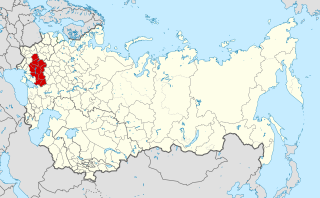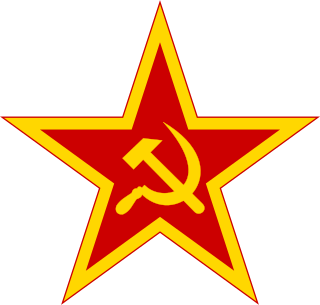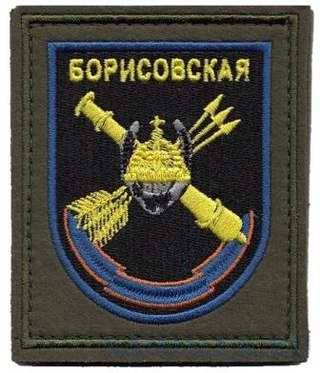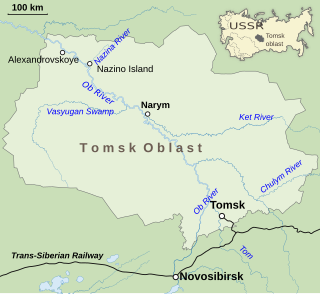
Tomsk is a city and the administrative center of Tomsk Oblast in Russia, located on the Tom River. Population: 556,478 (2021 Census); 524,669 (2010 Census); 487,838 (2002 Census); 501,963 (1989 Census).

Tomsk Oblast is a federal subject of Russia. It lies in the southeastern West Siberian Plain, in the southwest of the Siberian Federal District. Its administrative center is the city of Tomsk. Population: 1,047,394.

Nikolai Ilyich Kamov was a Soviet aerospace engineer, a pioneer in the design of helicopters, and founder of the Kamov helicopter design bureau.

Viktor Melkhiorovich Kress is a Russian politician. He is best known for serving five terms as governor of Tomsk Oblast, Russia from 1991 to 2012.
The Okorokov effect or resonant coherent excitation, occurs when heavy ions move in crystals under channeling conditions. V. Okorokov predicted this effect in 1965 and it was first observed by Sheldon Datz in 1978.

Herzel Yankel Tsam was a Jewish cantonist in the Russian Empire, one of only nine Jewish officers in the Tsarist army in the 19th century who didn't convert to Christianity.

The Kiev Military District was a military district of the Imperial Russian Army and subsequently of the Red Army and Soviet Armed Forces. It was first formed in 1862, and was headquartered in Kiev (Kyiv) for most of its existence.

The Soviet Army or Soviet Ground Forces was the main land warfare uniform service branch of the Soviet Armed Forces from 1946 to 1992.
Siberian Social-Democratic Union was a Siberian organization of Social Democratic groups. It was formed in the spring of 1901, by the initiative of the Tomsk Social-Democrats, including Social-Democratic groups from Krasnoyarsk, Irkutsk, and the Taiga. In the end of 1901 the union adopted a programme which defined its mission as fighting for political freedom of the proletariat, and for socialism. The union was initially dominated by 'economists'.
Yegor Anatolyevich Okorokov is a Russian former professional football player.

Vladimir Yevseyevich Zuev was a Soviet and Russian physicist, academician of the Academy of Sciences of the Soviet Union, Hero of Socialist Labour, USSR State Prize recipient, honorary citizen of Tomsk, expert in atmospheric physics and optics.

Vyacheslav Alexandrovich Kislitsyn is a Russian politician who served as President of Mari El in 1997–2001. During his presidency, he was responsible for much of the economic development in Mari El. At the same time, he was criticised for his autocratic ideology, accused of supporting Chechen rebels, and his supposed 'cult of personality'. In the 2001 elections, he suffered a tight defeat against his opponent Leonid Markelov, where Kislitsyn received 25% of the vote. Since then, his political whereabouts are left unknown.

Alexander Grigoryevich Melnikov was Soviet and post-Soviet Russian politician; Communist Party high-ranking official in 1986–1991; the First Secretary (mayor) of Siberian town of Seversk, the First Secretary (governor) of Tomsk (1983–1986), and Kemerovo regions. In 1990–2000's – head of CIS Ministry Managing department, advisor of the Union State Secretary. One of the leaders of the Communist Party of the Russian Federation.

The Siberian Nuclear Power Plant was built in the city of Seversk, Tomsk Oblast. It was the second nuclear power plant in the USSR and the first industrial-scale nuclear power plant in the country. While the Siberian Nuclear Power Plant did produce electricity, the primary product was weapons-grade plutonium for the Soviet Union's nuclear weapons program

The Volga Military District (PriVO) was a military district of the Soviet Union and the Russian Federation that existed from 1918 to 1989 and 1992 to 2001.
The 118th Estonian Guards Rifle Division was an elite infantry division of the Red Army and later the Soviet Army. It was formed following the German surrender in June 1945 from the 2nd wartime formation of the 7th Estonian Rifle Division. The division became a brigade in 1946 and became a division again in 1950. It was disbanded in 1956.
The 5th Anti-Aircraft Artillery Division was an anti-aircraft artillery division of the Soviet Union's Red Army during World War II.

The 140th Borisov Order of Kutuzov Anti-Aircraft Missile Brigade is an air defense brigade of the Russian Ground Forces' 29th Army in the Eastern Military District, stationed at Domna in Zabaykalsky Krai.
Vladimir Dmitrievich Vilensky-Sibiryakov was a Russian Bolshevik revolutionary and political activist involved in the Russian Revolution in Siberia and later a Soviet Comintern representative and historian.














